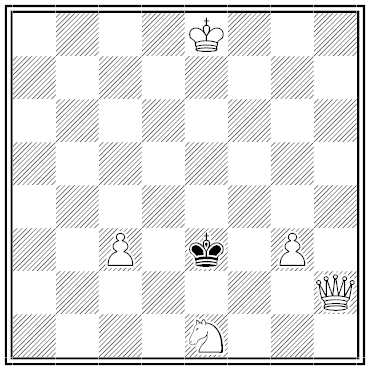“I have somewhere met with the epitaph of a charitable man, which has very much pleased me. I cannot recollect the words, but the sense of it is to this purpose; What I spent I lost; what I possessed is left to others; what I gave away remains with me.” — Joseph Addison
Author: Greg Ross
Quick Thinking
In summer 1940, Germany demanded access to Swedish telephone cables to send encoded messages from occupied Norway back to the homeland. Sweden acceded but tapped the lines and discovered that a new cryptographic system was being used. The Geheimschreiber, with more than 800 quadrillion settings, was conveying top-secret information but seemed immune to a successful codebreaking attack.
The Swedish intelligence service assigned mathematician Arne Beurling to the task, giving him only a pile of coded messages and no knowledge of the mechanism that had been used to encode them. But after two weeks alone with a pencil and paper he announced that the G-schreiber contained 10 wheels, with a different number of positions on each wheel, and described how a complementary machine could be built to decode the messages.
Thanks to his work, Swedish officials learned in advance of the impending invasion of the Soviet Union. Unfortunately, Stalin’s staff disregarded their warnings.
“To this day no one knows exactly how Beurling reasoned during the two weeks he spent on the G-Schreiber,” writes Peter Jones in his foreword to The Codebreakers, Bengt Beckman’s account of the exploit. “In 1976 he was interviewed about his work by a group from the Swedish military, and became extremely irritated when pressed for an explanation. He finally responded, ‘A magician does not reveal his tricks.’ It seems the only clue Beurling ever offered was the remark, cryptic itself, that threes and fives were important.”
(Thanks, John.)
Told You So
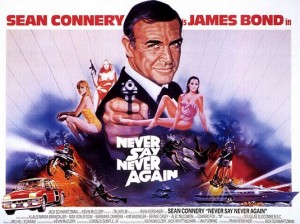
Never Say Never Again got its title because after Diamonds Are Forever Sean Connery had said he would “never again” play James Bond.
Travelogue
Once upon a time, a long while ago, there were four little people whose names were
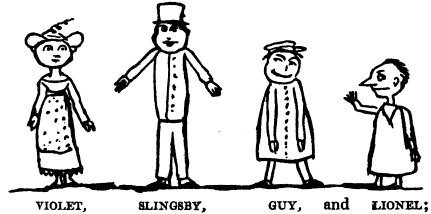
and they all thought they should like to see the world. So they bought a large boat to sail quite round the world by sea, and then they were to come back on the other side by land. The boat was painted blue with green spots, and the sail was yellow with red stripes: and, when they set off, they only took a small Cat to steer and look after the boat, besides an elderly Quangle-Wangle, who had to cook the dinner and make the tea; for which purposes they took a large kettle.
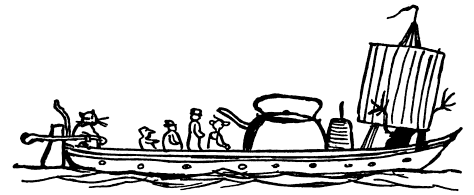
For the first ten days they sailed on beautifully, and found plenty to eat, as there were lots of fish; and they had only to take them out of the sea with a long spoon, when the Quangle-Wangle instantly cooked them; and the Pussy-Cat was fed with the bones, with which she expressed herself pleased, on the whole: so that all the party were very happy.
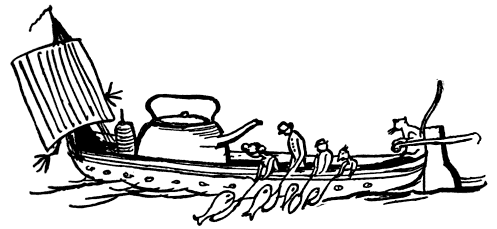
During the daytime, Violet chiefly occupied herself in putting salt water into a churn; while her three brothers churned it violently, in the hope that it would turn into butter, which it seldom if ever did; and in the evening they all retired into the tea-kettle, where they all managed to sleep very comfortably, while Pussy and the Quangle-Wangle managed the boat.
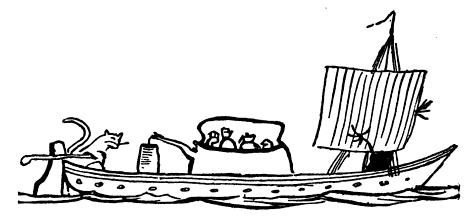
After a time, they saw some land at a distance; and, when they came to it, they found it was an island made of water quite surrounded by earth. Besides that, it was bordered by evanescent isthmuses, with a great gulf-stream running about all over it; so that it was perfectly beautiful, and contained only a single tree, 503 feet high.
When they had landed, they walked about, but found, to their great surprise, that the island was quite full of veal-cutlets and chocolate-drops, and nothing else. So they all climbed up the single high tree to discover, if possible, if there were any people; but having remained on the top of the tree for a week, and not seeing anybody, they naturally concluded that there were no inhabitants; and accordingly, when they came down, they loaded the boat with two thousand veal-cutlets and a million of chocolate-drops; and these afforded them sustenance for more than a month, during which time they pursued their voyage with the utmost delight and apathy.
— Edward Lear, “The Story of the Four Little Children Who Went Around the World,” from The Complete Nonsense Book, 1921
Fore!

In 1962 mycologist R.W.G. Dennis reported a new species of fungus he had observed growing in Lancashire and East Africa. He called it Golfballia ambusta:
The unopened fruit body evidently closely resembles certain small, hard but elastic, spheres employed by the Caledonians in certain tribal rites, practised at all seasons of the year in enclosures of partially mown grass set apart for the purpose. The diameter of the volva is approximately 3 cm., its surface smooth or regularly furrowed, becoming much wrinkled after dehiscence, its texture extremely hard and tough. A gelatinous stratum, so characteristic of other phalloids, is wanting. The appearance and texture of the immature gleba is still unknown but at maturity it is extruded as a column, thickly set with short strap-like processes of an elastic consistency, each scarcely 1 cm. long and 1.5 mm. wide, abruptly truncated at the free end. As with other phalloids, there is a strong and distinctive odour, in this instance not unpleasant and identified independently by several observers as reminiscent of old or heated india-rubber. This is probably a reliable and important diagnostic character. Taste not recorded but probably mild; the fruit bodies are unlikely to be toxic but may well prove inedible from their texture. Spores have not been recovered and the means of reproduction therefore remains unknown.
It seems to be very prolific in America as well.
(R.W.G. Dennis. A remarkable new genus of phalloid in Lancashire and East Africa, Journ. Kew Guild. 8, 67 (1962): 181-182.)
Comment
Ill wit.
Will it
Die out?
I doubt.
— K.F. Ross, Mensa Bulletin, April 1969
Last Words
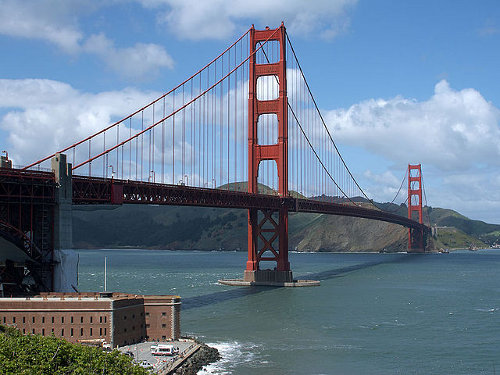
Suicide notes left by people jumping from the Golden Gate Bridge, gathered by Marc Etkind for Or Not to Be: A Collection of Suicide Notes, 1997:
“This is where I get off.” — Harold W., the first suicide, three months after the bridge opened, 1937
“Absolutely no reason except I have a toothache.” — 49-year-old John Thomas D.
“I am sorry … I want to keep dad company.” — 24-year-old Charles G. Jr., whose father had jumped four days earlier
“Do not notify my mother. She has a heart condition.” — Steven H., the 500th person to jump
“Why do they leave this so easy for suicide? Barbed wires would save a lot of lives.” — A 72-year-old man
“I and my daughter have committed suicide.” — A man who jumped with his 5-year-old daughter
“Loved Ones: My nerves are shot. Please forgive me. Chris” — A member of the San Francisco board of supervisors. This was a fake — he turned up a year later selling Bibles in Houston.
One person leapt with $36 in his mouth. “What he meant by this gesture is open to interpretation.”
“Obvious reasons for the bridge’s popularity are that it is easy and effective,” Etkind writes, “but there must be something more, for many suicides travel over the equally effective and accessible Oakland Bridge just to jump off the Golden Gate.”
Black and White
Green
There was an old grocer of Goring
Had a butter assistant named Green,
Who sank through a hole in the flooring
And never was afterwards seen.
Did he look in his cellar?
Did he miss the poor fellow?
Not at all. Quite phlegmatic,
He retired to an attic,
And there watched the moon in her glory o’er Goring —
A sight not infrequently seen.
— Walter de la Mare
Crime Does Not Pay
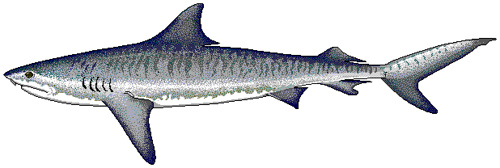
In 1799, the English cutter Sparrow intercepted the brig Nancy in the Caribbean. The area was forbidden to American ships, but the Nancy’s captain, Thomas Briggs, produced papers claiming she was owned by a Dutchman. Suspecting a smuggler but lacking evidence, the Sparrow’s captain sent Briggs to Jamaica to have his case heard by the vice-admiralty.
Two days later, another English ship, the Ferret, caught a large shark near the coast of Haiti. In its belly were the papers of the American ship Nancy — which Briggs had thrown overboard before getting false Dutch papers in Curaçao.
The “shark papers” were produced in court, and the Nancy and her cargo were confiscated.

